
A street that currently has no dedicated space for cycling is poised to become one of the most important bikeways in Portland.
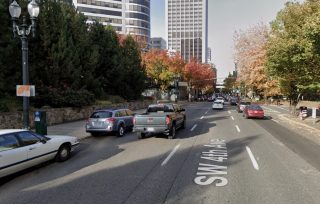
New concept plans revealed last week by the Portland Bureau of Transportation show bike lanes separated with concrete medians, protected intersections, new bike-only signals, and more.
Southwest 4th Avenue is already one of the most high-profile and important streets in the city. Its southern end connects directly to Barbur Boulevard with a bridge over I-405, then it runs adjacent to City Hall and the Multnomah County Courthouse before crossing Burnside under the Old Town gates en route to a relatively easy connection to the Broadway Bridge.
Bicycle users currently share the road with car users and compete for space among five car-centric lanes (two for parking, three for travel). The only upside to riding a bike on 4th is that it’s got a slight downward gradient which makes it easy to gain speed and — once you know the trick — easy to hit all the green lights (thanks to PBOT’s strategy of timing lights downtown for bike speeds of 12-15 mph).
SW 4th is one of the top priority projects in the Central City in Motion Plan (CCIM) that was adopted in 2018. The project boundaries are from SW Caruthers to Burnside.
PBOT Project Manager Gabriel Graff presented the latest plans to the PBOT Bicycle Advisory Committee last Tuesday (8/11). Here are some of the key takeaways.
Protection!
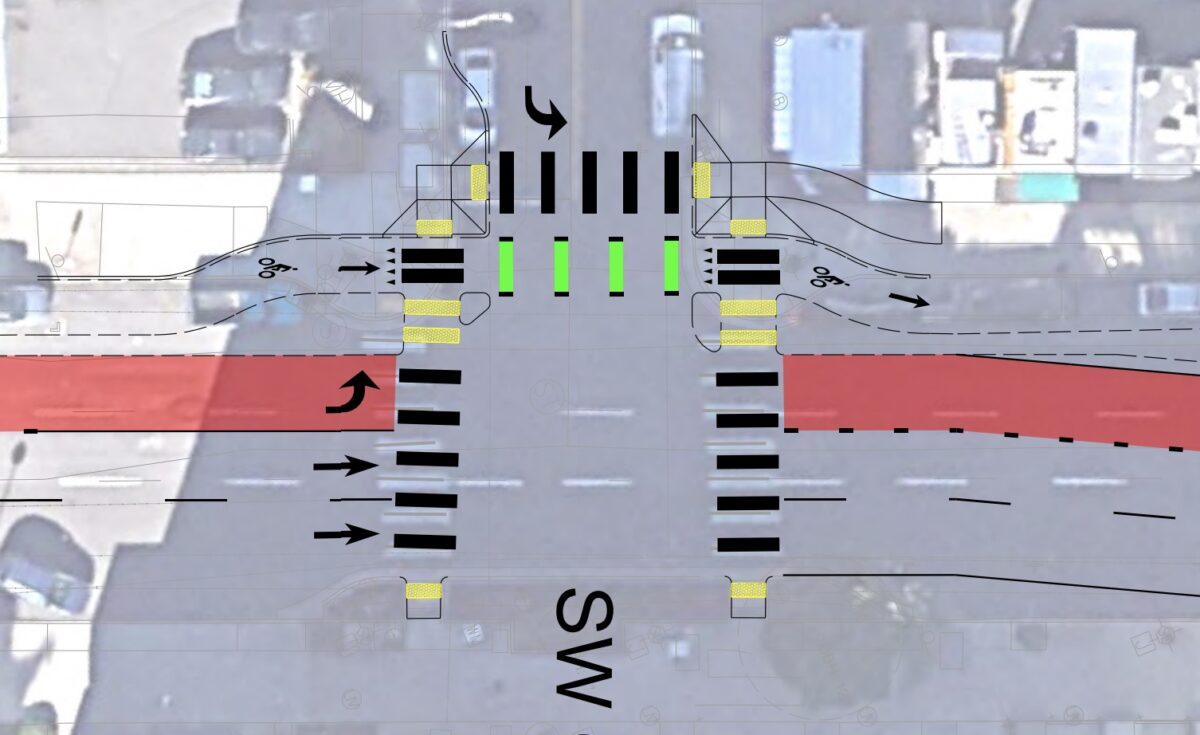
This project is a major capital improvement. That’s PBOT-speak for something that isn’t just “paint and posts”. This means it will have more funding and higher-quality construction that includes concrete medians to separate bicycle users from everything else. The concept shows a bike lane adjacent to the curb, then a concrete curb/median, then parked cars or a bus lane, then car users.
4th Ave will go from a shared environment between bike and car users to a dedicated biking facility with ample separation between modes. This type of build-out comes at a financial (project estimated to be about $3.4 million) and procedural cost. This project was first planned to break ground in 2020, then it was late 2021, and now PBOT says it won’t begin construction until 2022*.
Right to Left

The existing bike lane on SW Barbur is on the right side of the street. In order to avoid high-volume right-turns onto Willamette River Bridges and other destinations, the new bikeway will be on the left. The crossover will happen at SW Caruthers (just south of I-405). This means PBOT won’t have to deal with the freeway off-ramp merge that currently exists at SW Lincoln.
In order to facilitate the movement of bicycle users from right-to-left across two travel lanes, PBOT will install a new signal. The signal will allow bike riders to cross the intersection only while car drivers (headed straight) have a red light.
Addition of Bus-only Lane
Since the CCIM plan was conceived and adopted long before Commissioner Chloe Eudaly’s bus-focused Rose Lane Project, the 4th Avenue project didn’t include any bus-only lanes. Now it does. Plans show a new red-colored bus lane will run from SW Grant to SW Mill. This lane will carry six TriMet bus lines (the 9, 12, 17, 19, 43 and 44). The bus lane will be adjacent to the bike lane.
An existing bus stop currently on the right side of 4th near SW Hall will be relocated to the left side. PBOT plans to build a floating bus island at the northwest corner of Hall and 4th between the bus lane and the general travel lanes so bus operators won’t have to cross into the bike lane.
Onto the Sidewalk at Harrison
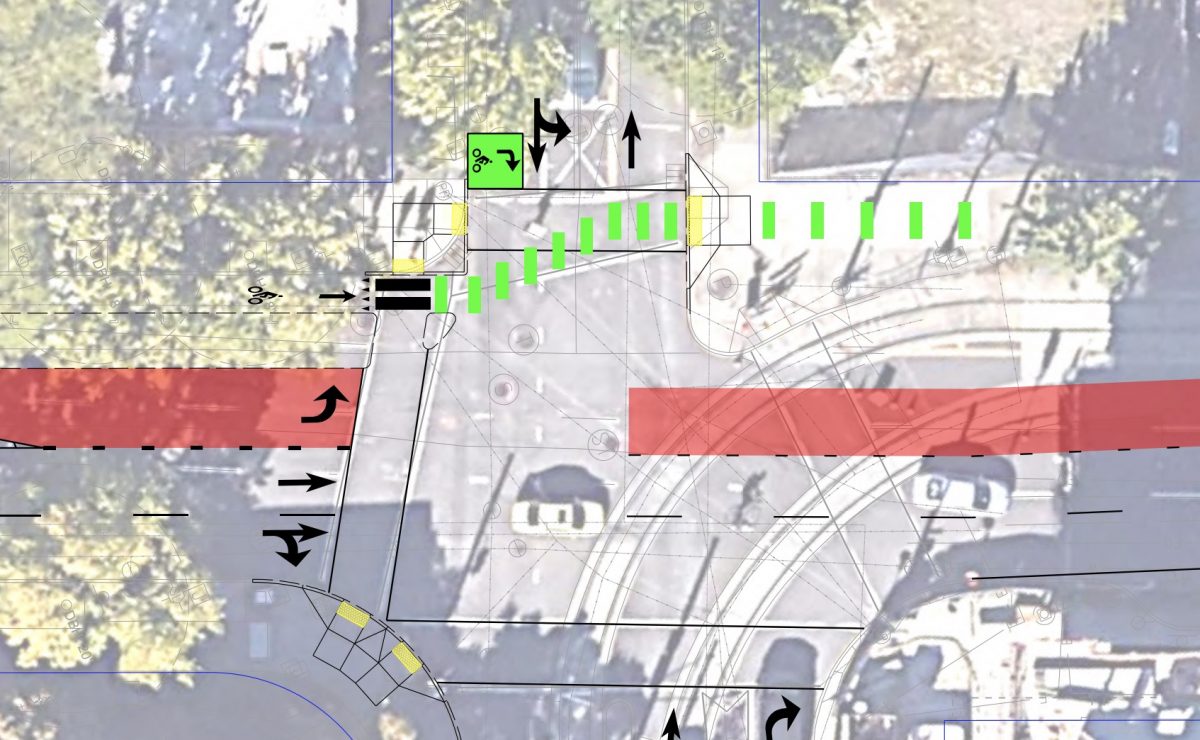
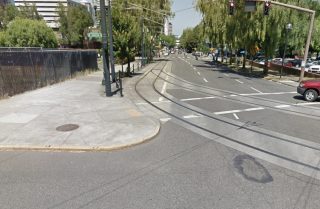
One of the trickiest intersections of the project is at SW Harrison where Portland Streetcar comes into play. With two sets of streetcar tracks running parallel on the left side of 4th Avenue for one block, it would be impossible to route the bike lane over them. PBOT has decided to avoid this hazard by routing the bike lane onto the sidewalk.
According to Graff, the new bike lane will be built adjacent to the existing bollard-and-chain fence (that keeps people away from tracks). A new building coming to that block will have a recessed facade so the sidewalk area is expected to be wide enough to handle bikers and walkers at the same time. “I wouldn’t say [putting a bike lane on a sidewalk] is the best-case scenario,” Graff said, and added that because there are no destinations on the other side of the bike lane (like car parking or a crosswalk), “We think it’s going to work reasonably well.”
About Those Left Hooks
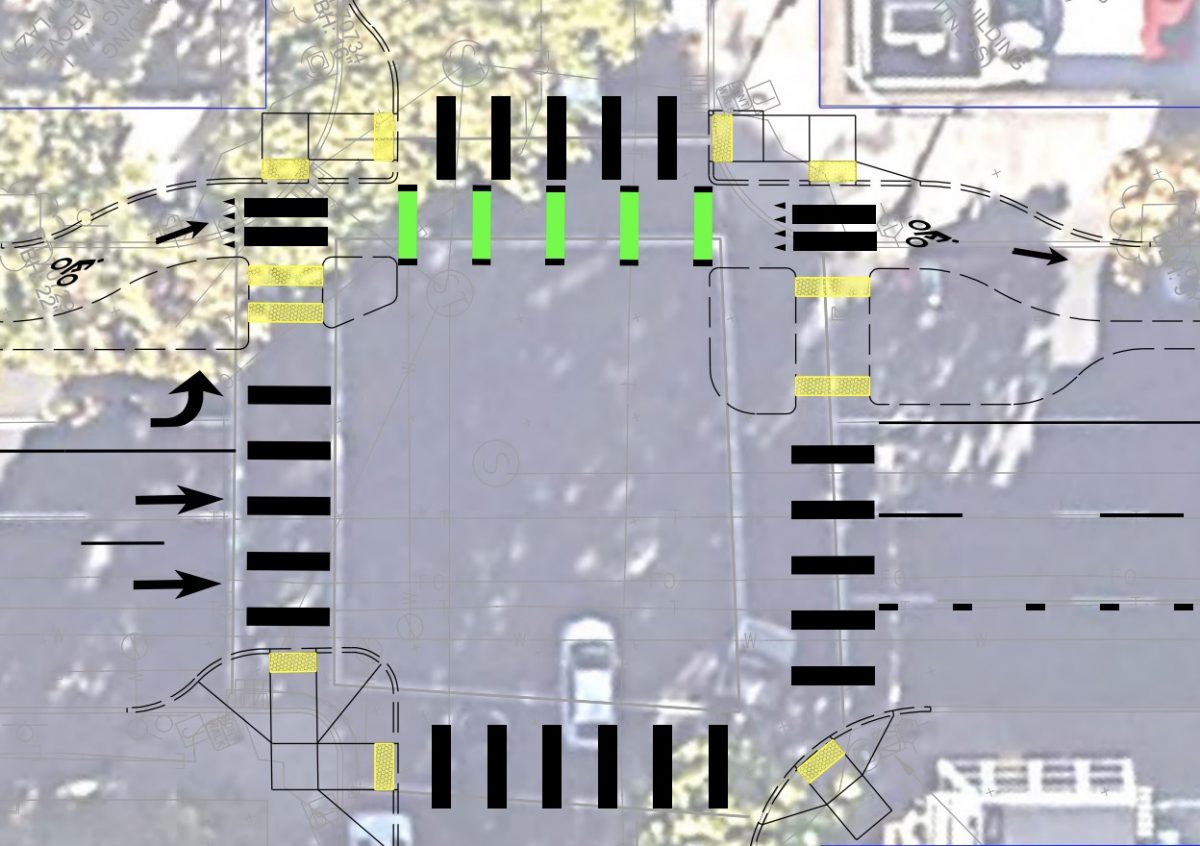
While PBOT chose to put the bike lane on the left side to avoid right-turning vehicles, there will still be left-turning vehicles that will create left-hook hazards. PBOT hopes to mitigate these risks by building either protected intersections or installing a bike signal where they expect high left-turn volumes.
Protected intersections include a more robust concrete median that creates physical separation and better sight lines between vehicle users. They are also cheaper and come with less delay than traffic signals. On corners with buildings that come right up to the property line, PBOT says there’s not enough room to build in the protected medians so they’ll opt for signals.
Northward Bound
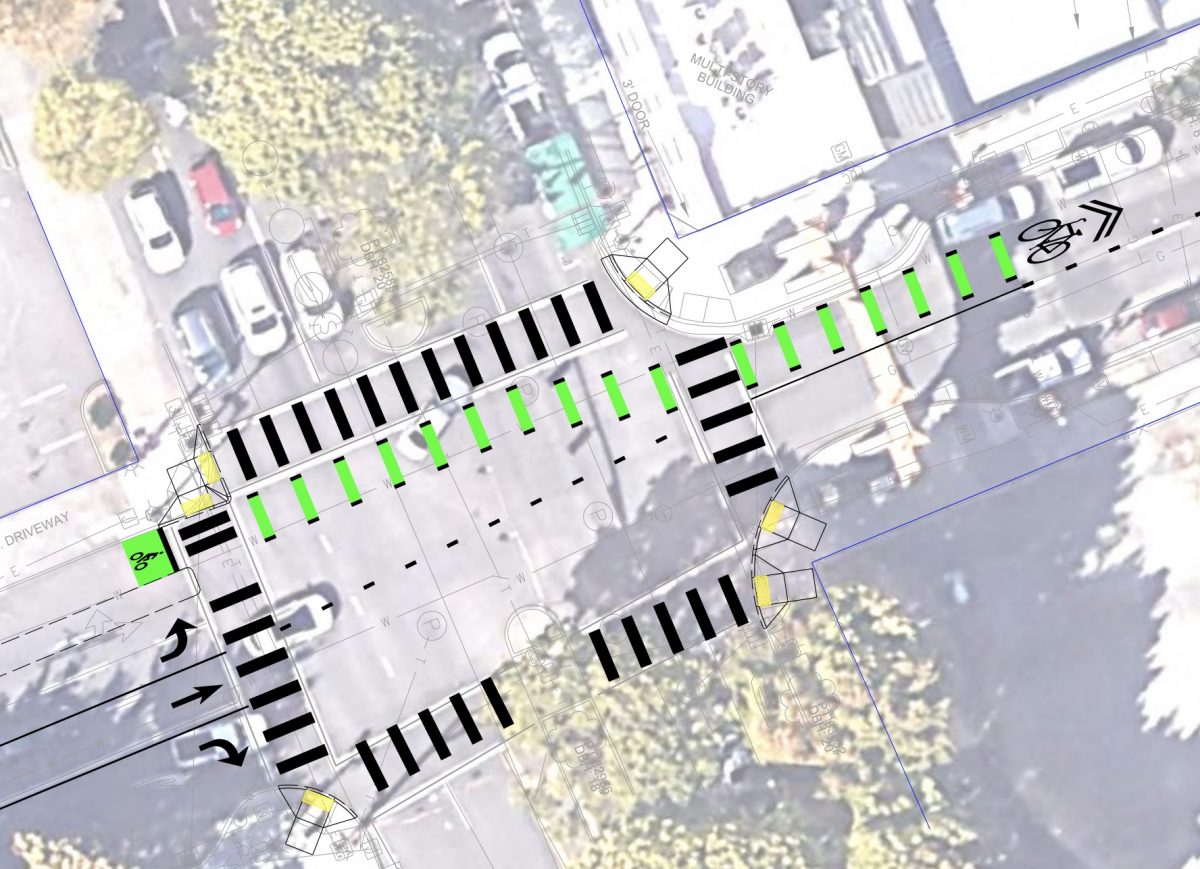
The northern terminus of this project is at Burnside where PBOT will install a new bike signal to separate northbound riders from westbound car drivers. Once into Old Town, SW 4th is calmer and narrower. PBOT plans to end the protected bike lane at Burnside and will install sharrows north of there.
If you’re riding to the Broadway Bridge or the Pearl, your best option would be to head west before Burnside at SW Oak. A related project on Broadway will come with a new northbound bike lane that will start at Oak. That project is slated to be installed (with paint and posts) this October.
It’s exciting to see this project come together, I just wish it wasn’t delayed until 2022. Asked at the BAC about the potential to do a quick-build, paint-and-post implementation while we wait for the full project, Graff said they’ve considered it but it would be “challenging”. “Our traffic engineers are worried about some of the left turns,” he said.
Don’t despair! About six of the ten CCIM projects currently in the works are slated to begin construction this year. Stay tuned for updates on those in the coming weeks.
*UPDATE: Here’s more on why this project has been delayed from PBOT Communications Coordinator Hannah Schafer:
“This project began as a Fixing Our Streets I paving project that rose up as a key northbound bike connection during the Central City in Motion planning process.
As part of that process, we decided to combine the paving work and installation of a new protected bike lane into one project. More recently, we have been working with TriMet and the Rose Lane team to add include a bus lane extending from SW Grant to Mill streets. Resolving the myriad design challenges of incorporating all these facilities in a busy downtown corridor has proved more challenging than we anticipated, and our Concept Design phase has been extended.
Our current schedule has us bidding this project in fall of 2021 and breaking ground in December of 2021, with the majority of construction work occurring in 2022.
— Jonathan Maus: (503) 706-8804, @jonathan_maus on Twitter and jonathan@bikeportland.org
— Get our headlines delivered to your inbox.
— Support this independent community media outlet with a one-time contribution or monthly subscription.



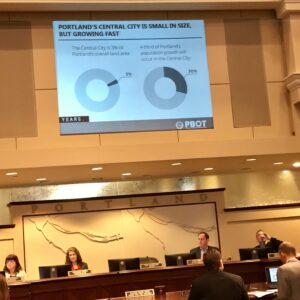
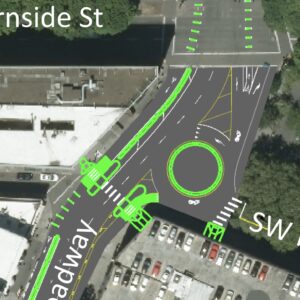
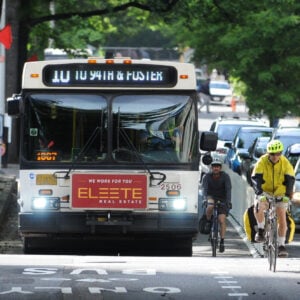
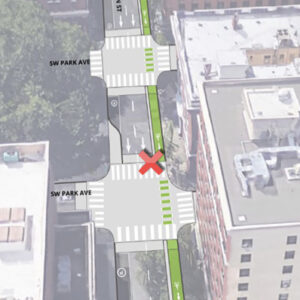
Thanks for reading.
BikePortland has served this community with independent community journalism since 2005. We rely on subscriptions from readers like you to survive. Your financial support is vital in keeping this valuable resource alive and well.
Please subscribe today to strengthen and expand our work.
Aaargh!!! Before the pandemic, I used to ride 4th a lot from Hawthorne to Old Town, and always took the center lane to avoid contending with turning vehicles. It’s flat or downhill for much of its length, and my main problem was riding slow enough to time the signals right.
With this “upgrade”, I’ll be legally required to ride in the curb lane and will have conflicts with bleary eyed commuters turning across my path every block, dramatically increasing the danger.
I’m more positive about the improvements to the south (except for the on-the-sidewalk section, which will be “interesting” given the gradient and therefore speeds involved). That section was always a bit more dicey given the tracks, congestion, and generally more chaotic nature of the traffic and street configuration.
This is an “improvement” I am highly unexcited about. Put this on Broadway instead.
I am in total agreement with you from my normal use of 4th as well. Pre-pandemic, I would ride in the afternoons from Hall or Market north to Burnside, taking the middle lane until passing Alder, then moving right and taking the right on Burnside to cross the river. Rarely had a conflict with cars, and traffic clears up a lot north of Alder in the afternoons.
Could we at least get a protected right hand turn on Madison for the Hawthorne bridge, and one on Alder for Morrison?
I couldn’t agree more strongly with the comments so far. This is a terrible project and will accomplish the following for cyclists:
– Bring every cyclist to a stop at SW 4th & Caruthers, to wait for the light while all cars are stopped, so the cyclist can get to the protected bike lane on the left side of 4th Ave (just like the southbound entry to the new protected lane on Greeley in north Portland);
– Put cyclists in conflict with vehicles turning left from 4th Ave, including the many northbound buses moving from 4th to the bus mall;
– Put cyclists in conflict with every pedestrian who now has to cross this dedicated bike lane – I foresee one thousand spilled coffees and lunches as bikes surprise peds carrying their food away from the food-cart pod.
I’ve ridden north on 4th hundreds of times and rarely have had a problem. As others have noted, the gentle downslope allows you to gain speed easily and ride with traffic. The off-ramp from I-405 just after the overpass (just south of Lincoln) can be a little stressful, but if you gain speed and move left, you can avoid cars easily. Also the traffic turning right from 4th onto Madison (to reach Hawthorne Bridge) can be a pain b/c there’s no dedicated space for bikes. But that could be fixed with some paint.
If the goal of this project is to allow parents on bikes with children on bikes to ride cautiously downhill, braking at every intersection and waiting as trucks, buses, and cars turn left in front of them, and slow down at every intersection to avoid pedestrians, then this project will be a success.
But if the goal is to move commuters and other confident cyclists quickly and efficiently northward into downtown, then it’s going to be a failure. I will continue to want to ride with traffic. I’m sure someone at PBOT will say, To heck with you, then. But this type of project only marginalizes bikes, and is really designed to put them out of the way of cars, so cars can continue to move more quickly and efficiently, while that goal is sacrificed for bikes.
“If the goal of this project is to allow parents on bikes with children on bikes to ride cautiously downhill” …..
I think it is? Don’t get me wrong- I’m with all y’all that happily take the middle lane on 4th for a fast and relatively easy way to speed through town to Burnside. BUT transportation advocates, policy people, etc have been advocating for 8 – 80 infrastructure on Portland streets for years and this is what it looks like. It’s slower, less convenient, and it’s built for the 8 and 80 year old. Same can be said about the various complaints about the new Greely path. For better or worse, when we build for the least able or confident cyclist we prioritize separation of modes and movements over speed.
Kcommentee,
I agree with you that to make a system that works for the 8-80 crowd, there will be some compromises that do not work as well for the strong and fearless set. However, I do not think that is what is happening here. PBOT is sacrificing convenience and bit of safety because they do not want to address the dangerous merge onto 4th form 405. This be resolved a couple of different ways, but that might slightly impact people driving, so the PBOT compromise is to shunt bikes across the street (guaranteed long wait times) then have bikes ride on a sidewalk for a block (what?!). This cuts the bike route from what is a major use: connecting to bridges in a direct, convenient way. From your post, I think you were implying that this design is a necessary compromise to achieve safety, but I believe it is an unnecessary compromise to benefit drivers at the expense of safety and convenience of people biking.
I feel the same way. For people (like me) who are comfortable playing amongst car traffic, 4th can move pretty quickly, which is nice. With all this separated and protected infrastructure, some mixed with pedestrians, I don’t think it will move nearly as quickly. Shoving bicycles onto the west sidewalk at Harrison avoids the streetcar tracks coming up Harrison and turning north, but you’ll still be forced to deal with the tracks at Montgomery. How will that look?
The plans feel like they run counter to the “vehicular cycling” philosophy. If I want to drop down to Harbor Dr at Market, will that still be possible as an easy right-turn or will I have to pull left from 4th onto Market, re-orient, wait for the light, and then proceed east?
I suppose there’s an alternative in cutting over on Lincoln through Lovejoy, jog over a block on Market from 3rd to 2nd and continue north.
This should have been a center running protected bikeway with bike turn lanes. Drivers would have to pick their lane at each intersection like they do on the bus mall – or turn three times.
Absolute agreement. In current conditions I usually choose SW 4th Avenue over 6th because two or three lanes flow better than one lane that has to handle both turning and through traffic. This plan might change that.
I wake up every morning knowing that I’m going to break a certain number of traffic laws before sundown. This sort of thing makes that number larger. Fortunately for me Portland hasn’t figured out how to do traffic enforcement. In twenty-odd years of biking through downtown I’ve received one traffic ticket, knock knock, which kind of shows how much of a (cough) I am but also says bikes are a minor threat and that cops really have more important stuff to do.
The article says that lights progress at 12-15 mph through downtown. This is true except when it isn’t–in recent years there has been an increasing tendency for variation near bridges at commute times or sometimes more randomly, with lights being out of synch as a result of some malfunction. Maybe the light timing is changed on occasion as part of some experiment or to discourage aggressive driving? I don’t know but a few times I’ve found myself rolling into a red that was supposed to be green in my private Portland…never assume!
I think the max has something to do with that
This looks like a big waste of money!
Put Sharows in all the lanes and call it good.
I can coast down 4th faster than the lights can change.
Dedicated bike lanes will only limit where one can bike on SW 4th.
At Harrison, there should be an option to ride in the bus lane, no? In Old Old Town, it appears that the curbside parking will remain. Why? Finally, The transitions of the protected intersections are too tight. They have made the same mistake on Rosa Parks, at Burnside and 18th, and at new 20th intersection in Slabtown.
I don’t think there’s anything in the design that would stop someone from merging right and riding in the bus lane between Harrison and Montgomery, but that one block also has northbound streetcar tracks so it’s not a great idea to do so. (The Google streetview image above shows the condition prior to 2015, when a second track was added). The fact that the route will merge onto the [wider than normal] sidewalk is pretty unfortunate, but I don’t see an easy solution given the existing conditions.
The project isn’t doing any construction north of Burnside. In the longer term I think it would be a good idea to remove the parking on the west side of 4th, but that would require rebuilding all the existing corners, and would add quite a lot of work to the scope of this project.
The bike lanes proposed on SW 4th are 8′ wide, so quite a bit wider than the 5′ wide ones built on NW 20th (it helps that 4th is a wider street, and the bike lanes are only being built on one side). I do think it’s worth noting that while they’re showing protection at the intersections, they aren’t really designing any protected intersection yet, if that makes sense? i.e. the intersections at SW Taylor and SW Salmon don’t show the bikes lanes that are planned for those streets. What is currently shown would need to be ripped out when those projects get built, so I hope that gets resolved in the next iteration of the design.
IMO, it is mistake to move the bike lane to the left side of the street. The freeway offramp should not “merge” with a city street as if it is another freeway, that should be rebuilt to intersect with 4th at a right angle with a signal. At a minimum, access from the ramp on to 4th could be controlled with a signal. If the bike lane was on the right side of the street, connections to the the bridges and the waterfront would be maintained and you could avoid the awkward, bike-only diagonal intersection crossing.
I agree with you on the need to rework the off-ramp to eliminate the high-speed merge behavior. But if PBOT had to convince ODOT to redesign an interstate off-ramp — then arrive at a mutually acceptable design — this project wouldn’t be starting construction anywhere near as soon as 2022.
Plus it’s not just this ramp that would create a conflict point — the three right turns to the river bridges would likewise be very high conflict locations for a right-hand bike lane.
I agree with you that people traveling o n4th will want to turn right to access the bridges, but that is kind of my point. People on bikes will want to make that move, but because it is also common fro people driving, PBOT has elected to move bikes out of the way rather than address the design to make it safe for bikes. This design is another example of “increased speed and convenience” for people driving and “slower, less direct, less convenient but safe” for people on bikes. There ARE ways to design a route that is safe AND convenient for people on bikes, but PBOT is unwilling to do anything that does make it easier an faster to drive. I appreciate the protected portions of the bike route, but the overall route and the implications to the bike network are disappointing. PBOT keeps take one step forward and 2 steps bike with these bike designs, we should demand better!
I guarantee that replacing a vehicle lane with a dedicated bike lane does nothing to make it faster to drive.
But what if I only want tofu from the food cart pod, not beef? 😉
But in contrast to some of the other posters here I do like this project. Remember that the majority of cyclists may not be comfortable taking the lane on 4th and thus have no easy northbound bike route into downtown. After this they will.
Yes, but… it’s the wrong lane. The center lane is the safe one. Is “comfort” more important than safety?
Hmmm, that Forester guy, he was right at least twice a day, or maybe even a little more than that.
This is going to massively slow down and inconvenience bikes. They’re should just be a protected bike lane on the right in the fast steep section, with street parking removed. All it would take to deal with the 405 off-ramp issue is keep the bike lane across the overpass (by removing the left-side street parking Grant to Lincoln), and have the signal at Lincoln alternate between 4th and the off-ramp so bikes don’t have to merge. And the right hook issues farther down could have bike signals/ no right-turn signs like Broadway/Williams. Where do they think bikes are going? Old Town? No, we’re turning right to get to the Hawthorne bridge or Better Naito. Duh.
I ride down 4th a lot on my commute home from Marquam Hill to SE. Most often I turn right at Madison to get on the Hawthorne Bridge. I’m totally comfortable mingling with traffic because it rarely is going much faster than I can and if I stick to the middle and right lanes I’m able to cruise most the way down 4th even when there is a lot of traffic. I’ve never had an issue going by the off ramp from 405. There is a light at Lincoln that allows you to either continue in the middle lane if it is green or move over to the right lane if it is red. There is a concrete median that almost goes all the way up to the cross walk at Lincoln, so the off ramp only really poses a challenge if traffic is heavy and you want to turn right on to Lincoln from 4th during a green light. As a bike commuter though I’d much rather ride on the right side of the street than the left. If I need to turn left I can maneuver into the westbound traffic lane of the cross street while that street has the red light. This is a common set up around town. Oh, and the streetcar tracks crossing is not a major concern if you’re riding in the right lane. Traffic engineers need to actually observe how bike commuters are currently using 4th and then base their designs off those observations.
One thing I do have substantial worry about is the diagonal crossing at Caruthers. Frankly, that intersection is absolutely atrocious, and the backup from the even-more-poorly-designed 6th and Broadway intersection causes the 4th and Caruthers intersection to be constantly blocked by cars. I worry that even when the bike signal is green that cyclists simply won’t be able to go because of poor driver behavior. I wish they’d move the crossing to somewhere on the 405 overpass itself, installing a new signal there.
Excellent point. Have traffic engineers observed how car traffic stacks up at that intersection during rush hour?
That was my first thought, too. But I think that crossing Caruthers is an issue regardless of the new diagonal because of the constant back-up. I don’t think the diagonal makes it any worse. You’re going to have to squeeze through cars illegally blocking the intearsection nywayregardless.
I think the bike lane will be useful for commuters. I work a couple blocks from here and I wouldn’t dream of biking on 4th during rush hour because it’s often backed up with cars in all lanes. Having a separate facility would allow me to reconsider that. I agree that 3rd and 4th are nice to ride on when traffic is limited though. Like others, I take the center lane. While bike speeds may be a little more slow than free flow, it will be substantially faster than rush hour gridlock.
Perhaps what we need is a change to the law to allow bikes to occupy vehicle lanes in reasonable conditions so that more confident folks can take the lane and ride with traffic speeds when lanes are free flow?
Great point. I like mixing with traffic on 4th when it’s moving. But I’ve definitely been stuck in the rush hour morass. This will be helpful during those times.
JM, I have a concern to share with you, followed by a question:
My concern is that BP is becoming an uncritical cheerleader for this type of cycling infrastructure. I’m wondering if you are really asking the most important question – Is this design really good for cycling? – and instead just saying to yourself: PBOT is willing to spend the money, so we should just be grateful for whatever they want to build for us.
I would be happy to read a really thoughtful analysis of PBOT’s current design thinking (if you have already written it, please share the link). Whom is the design for? Whom is it designed to benefit? My guess is that PBOT planners are driven by a desire to increase cycling’s mode-share numbers. What are the people who are NOT currently cycling saying about what would get them to cycle? – they are probably saying “Whatever helps me feel safe,” which then drives PBOT to create these awful stop-and-cross, put-you-off-by-yourself-and-in-conflict-with-peds-and-turning-vehicle designs. It’s a “build it and they will come” strategy. But does it actually work? Is it possible that a freer-flowing, interaction-with-traffic model that moves bikes more quickly and efficiently, combined with intentional efforts to train cyclists to ride with traffic, would achieve better results in the long run?
If someone has already done this research, I would love to know about it. Otherwise I’m afraid PBOT is going to spend millions on cycling infrastructure that very few cyclists actually like AND fails to attract the uncycled masses.
Since I approach stories like this as a news person and not an advocate, I usually just try to share what PBOT is doing — without injecting too much criticism or opinion. I’m pretty sure that’s what I did here. I realize that often people will read something on BP and assume that its mere presence means I am “pushing” for it. That’s not always the case and I urge you to read my words closely before speculating about my motives.
That being said, what you are voicing here is essentially a vehicular cycling mindset versus the more European/Dutch-style mindset that is currently favored in Portland. Both of those are valid in my opinion, but overall when we are building bikeways in dense urban areas I feel like we have to make sure they are comfortable for beginners and the “8-80” riders. If you want to mix with traffic, go right ahead and continue to take the lane (yes I’m aware of our ridiculous mandatory sidepath rule but 1) it’s highly unlikely it will come into play and 2) we’re gonna’ get that changed at the legislature soon enough).
If that sounds unreasonable, then consider asking yourself your own question: Has sharing the road with drivers worked? I haven’t seen any American city (or any city anywhere for that matter) go beyond 4-5% mode share without physically protected, signalized, and connected bikeways.
As a paying customer, I would prefer a clearer delineation between the “newsroom” and the “editorial staff”.
As time passes, you seem to be increasingly blurring the lines more between straight news and opinion, so it’s not unreasonable that people would start confusing one for the other. It should not require a close reading to make a distinction.
I have a strongish preference for the newsroom content, which presents information and provokes discussion I don’t find anywhere else. It’s what keeps me here. Much of the opinion seems to follow the party line, and, with the occasional exception, the resulting discussion seems to read from the same general script. I can get that anywhere, and, tiringly, everywhere.
these are blurry times Hello Kitty. Sorry if the line isn’t always as clear as you’d like it to be. Sometimes I think stuff needs to be said loud and clear and front and center. I appreciate your feedback and will keep it in mind.
So does the Wall Street Journal; yet they usually manage to clearly mark their opinion pieces as such.
I’m not saying you shouldn’t say what you feel needs saying; I’m saying that when you say it, say what you’re saying.
Thanks, JM. That’s helpful, though I’ve cycled in Europe quite extensively and nothing about their system of signalized paths feels remotely like what PBOT is building. I can’t think of any paths I’ve ridden there that put me directly in conflict with left-hook-turning vehicles or pedestrian areas like the food-cart pod. In fact, the whole idea of putting cycles on the left seems arbitrary and non-standard, and I can’t imagine it being tried anywhere but Portland. The place in Portland I’ve come closest to being killed was on N Williams when a van left-hooked me b/c the driver just didn’t imagine a bike would ever be passing on his LEFT (!); thank goodness the truck driver behind him laid on his horn and caused him to brake sharply.
I do actually read your words quite carefully, and to Kitty’s point I would say a sentence like this one:
“It’s exciting to see this project come together, I just wish it wasn’t delayed until 2022.”
probably crosses the line between reporting the news (what’s happening) and editorializing about the news (it’s exciting!). I actually like your sense of boosterism for cycling in Portland – it’s what keeps me coming back to the site. But if you are going to be a booster, then I would just want you to think really carefully and maybe test the waters of public opinion before boosting ideas and schemes that end up hurting cycling in Portland.
There are a few phrases that frame the article as an opinion piece;
“A street that currently has no dedicated space for cycling is poised to become one of the most important bikeways in Portland.”
It has the potential, the need is there, it is ina good location, but will this design achieve the potential? Who is claiming it could become an important bikeway?
“It’s exciting to see this project come together”
Is it? Or is it disappointing to people hoping for a route better connected to the bridges, or a route without the built-in delay of a dedicated, diagonal crossing, or a brand new bike route on a sidewalk, permanently reducing the quality of the bike route and the sidewalk
Thanks for stating this explicitly Jonathan. People advocating for fast vehicular cycling can exist with or without this infrastructure. But it won’t make our places more safe and sustainable, and it won’t help other people feel safe using a bike or walking.
If I want to ride in a traffic lane, I can’t do that with this infrastructure — at least not legally.
“Is it possible that a freer-flowing, interaction-with-traffic model that moves bikes more quickly and efficiently, combined with intentional efforts to train cyclists to ride with traffic, would achieve better results in the long run?”
If it were we would not have stagnated our mode share for decades while cities like Amsterdam and Copenhagen have made cycling something almost everyone does.
This comment presupposes that the reason our riding rates are lower than Amsterdam and Copenhagen is the infrastructure. I think that’s a far from settled question. Riding in Japan is something almost everyone does, and they don’t have much separated infrastructure at all.
At this point vehicular cycling in urban areas is largely a faith. It’s the “Why do we have sidewalks… can’t people just run with cars!?” of the pedestrian world.
Remember Amsterdam looked almost the same as Portland in the 70s. What changed? Japan is a great example of using max 30-40km/hr (~20-25mph) in largely pedestrianized and local streets for cycling infrastructure. Kind of like using NW 13th to generalize about Portland streets.
Looks like quite a few people in the comments aren’t a fan of this. I’m someone who will cycle on 4th Avenue as it is today, but most people I know who aren’t regular Bike Portland readers won’t. It takes a lot of confidence to cycle in busy mixed traffic, and it took me a long while to get there.
A few years ago I was in Vienna, and explored a lot of it by bike. While they don’t have a lot of dedicated bicycle infrastructure in the very Innere Stadt—the most visisted area by tourists—they do in the neighborhoods surrounding it, which are all very dense by Portland standards. This is one street I cycled along, which has a pretty similar configuration to what’s proposed for 4th (except for the fact that’s the path is narrower in Vienna). It felt comfortable to ride on in a way that busy streets in Portland never do. I don’t think it was unrelated that I noticed a lot of people riding on it, which I don’t see on 4th.
In the past decade we’ve built very little bike infrastructure in downtown / the central city, and what we have built has been low quality. We’ve also seen no significant change in bicycle ridership. I’m excited that, for a change, there seems to the be ambition to build something that’s high quality and that will attract people who aren’t comfortable with vehicular cycling.
(your one street link goes nowhere)
It’s great to build separated and protected infrastructure. It’s great to have bikeways that new riders can feel safe riding. We need that.
We also need bikeways that serve a purpose analogous to freeways, to move people from point A to point B with minimal delay. In my mind, 4th is a freeway, and this project is tearing out the freeway to make it a local access street. Not everyone will be comfortable on freeways, but that means they need comfortable
alternatives, not that freeways should be removed, which impairs mobility for those who are comfortable using them.
I wonder if there would be a way to build some protective infrastructure on a parallel route for those who wanted a bit of isolation from traffic (even at the cost of greater danger from left hooks). Maybe SW 2nd has room for, say, a parking protected bike lane. Then we could leave SW 4th as the faster, safer route.
Hmmm, looking at the page source it looks like the URL was stripped out of my comment. I’ll try it this way: https://goo.gl/maps/uqE9fVTh9tUvajNa7
I would disagree that 4th Ave functions as a bicycle freeway today. The number of people on bikes who are using that is low, and we can do better.
The road cyclist ideal lives strong in Portland and the US in general, primarily because we have virtually no safe infrastructure. We hear “But I feel comfortable riding in x street!” any time a pbl is proposed. Anyone who has seen the effects of street pedestrianization or PBLs knows how transformational they can be. It’s just one more unfortunate hurdle in making streets places where everyone can move, not simply the few who feel safe with cars.
I would welcome a pbl on 4th, but I lament the proposal to include an awkward diagonal crossing and the (IMO) unforgivable design decision to ruin a full block of downtown/PSU sidewalk by mixing bikes with pedestrians. A pbl would be great on the right side of the street. My complaint is that PBOT is compromising the bike route and the pedestrian realm fora n expensive, new piece of infrastructure because they are unwilling to deal with an highway onramp.
I hear you on the diagonal crossing. As I recall Greeley’s new crossing signal for bikes on the diagonal at Going does not allow adequate time. It made for a very awkward and somewhat unsafe situation. Overall my hope is that PBOT start installing PBLs en masse. Maybe if Wheeler gets voted out, we might have a chance for once. Working out the design details might take a while however.
Is it just me or are none of the images provided following cardinal north? It really confuses the eyes and the brain.
Listening to Hannah is a snooze fest. Also, what’s protective about the left hook we will greeted with on left turns? I usually ride fourth daily and still do 2-3 a week. This looks like that trash filled road that is SW 2nd. Poor bike design that I will refrain from using.